Assessing the Impact of Ammonia Emissions from Mink Farming in Denmark on Human Health and Critical Load Exceedance
Abstract
1. Introduction
2. Methods and Data
2.1. Regional Scale Modelling
Setup of the DEHM
2.2. Human Health Impact Assessment
2.3. Local-Scale Deposition of Nitrogen
- Category 1: NH3-sensitive nature types within Natura 2000 areas including heathland and dry grassland in Natura 2000 areas.
- Category 2: Selected NH3-sensitive nature types outside Natura 2000 areas, such as heath areas larger than 10 ha, dry grassland larger than 2.5 ha, raised bogs, and lobelia lakes.
- Category 3: All NH3-sensitive nature types outside Natura 2000 areas that are not included in Categories 1 and 2; heaths, bogs, dry grasslands and NH3-sensitive forests.
3. Results
3.1. Health Effects and Related Socio-Economic Costs Calculated with EVA
3.2. Nitrogen Deposition and Critical Load Exceedances
3.2.1. Local-Scale Deposition of Nr
3.2.2. Critical Load Exceedances
4. Conclusions/Discussion
Supplementary Materials
Author Contributions
Funding
Institutional Review Board Statement
Informed Consent Statement
Data Availability Statement
Conflicts of Interest
References
- DSt. Fur Production in Denmark, Statistics Denmark. 2025. Available online: https://statistikbanken.dk/statbank5a/default.asp?w=1175 (accessed on 18 March 2025).
- Buchholz, K. Global Fur Production in Drastic Decline, Statista. 2025. Available online: https://www.statista.com/chart/33876/supply-volumes-of-mink-fox-pelts-on-the-world-market/ (accessed on 18 March 2025).
- Fenollar, F.; Mediannikov, O.; Maurin, M.; Devaux, C.; Colson, P.; Levasseur, A.; Fournier, P.E.; Raoult, D. Mink, SARS-CoV-2, and the Human-Animal Interface. Front Microbiol 2021, 12, 663815. [Google Scholar] [CrossRef]
- Stevens, C.J.; Duprè, C.; Dorland, E.; Gaudnik, C.; Gowing, D.J.G.; Bleeker, A.; Diekmann, M.; Alard, D.; Bobbink, R.; Fowler, D.; et al. Nitrogen deposition threatens species richness of grasslands across Europe. Environ. Pollut. 2010, 158, 2940–2945. [Google Scholar] [CrossRef]
- Midolo, G.; Alkemade, R.; Schipper, A.M.; Benítez-López, A.; Perring, M.P.; De Vries, W. Impacts of nitrogen addition on plant species richness and abundance: A global meta-analysis. Glob. Ecol. Biogeogr. 2019, 28, 398–413. [Google Scholar] [CrossRef]
- De Vries, W. Impacts of nitrogen emissions on ecosystems and human health: A mini review. Curr. Opin. Environ. Sci. Health 2021, 21, 100249. [Google Scholar] [CrossRef]
- Grennfelt, P.; Engleryd, A.; Forsius, M.; Hov, Ø.; Rohde, H.; Cowling, E. Acid rain and air pollution: 50 years of progress in environmental science and policy. Ambio 2020, 40, 849–864. [Google Scholar] [CrossRef] [PubMed]
- De Vries, W.; Hettelingh, J.P.; Posch, M. (Eds.) Critical Loads and Dynamic Risk Assessments: Nitrogen, Acidity and Metals in Terrestrial and Aquatic Ecosystems. Environmental Pollution Series; Springer: Dordrecht, The Nederlands, 2015; ISBN 978-94-017-9507-4. [Google Scholar] [CrossRef]
- Hettelingh, J.P.; Posch, M.; Slootweg, J. (Eds.) European Critical Loads: Database, Biodiversity and Ecosystems at Risk; CCE Final Report 2017, Coordination Centre for Effects; RIVM Report: Bilthoven, The Netherlands, 2017. [Google Scholar] [CrossRef]
- Payne, R.J.; Dise, N.B.; Field, C.D.; Dore, A.J.; Caporn, S.J.M.; Stevens, C.J. Nitrogen deposition and plant biodiversity: Past, present, and future. Front. Ecol. Environ. 2017, 15, 431–436. [Google Scholar] [CrossRef]
- Dirnböck, T.; Grandin, U.; Bernhardt-Römermann, M.; Beudert, B.; Canullo, R.; Forsius, M.; Grabner, M.T.; Holmberg, M.; Kleemola, S.; Lundin, L.; et al. Forest floor vegetation response to nitrogen deposition in Europe. Glob. Change Biol. 2013, 20, 429–440. [Google Scholar] [CrossRef] [PubMed]
- McClean, C.J.; van den Berg, L.J.L.; Ashmore, M.R.; Preston, C.D. Atmospheric nitrogen deposition explains patterns of plant species loss. Glob. Change Biol. 2011, 17, 2882–2892. [Google Scholar] [CrossRef]
- Han, W.J.; Cao, J.Y.; Liu, J.L.; Jiang, J.; Ni, J. Impacts of nitrogen deposition on terrestrial plant diversity: A meta-analysis in China. J. Plant Ecol. 2019, 12, 1025–1033. [Google Scholar] [CrossRef]
- De Schrijver, A.; De Frenne, P.; Ampoorter, E.; Van Nevel, L.; Demey, A.; Wuyts, K.; Verheyen, K. Cumulative nitrogen input drives species loss in terrestrial ecosystems. Glob. Ecol. Biogeogr. 2011, 20, 803–816. [Google Scholar] [CrossRef]
- Pope, C.A.; Coleman, N.; Pond, Z.A.; Burnett, R.T. Fine particulate air pollution and human mortality: 25+ years of cohort studies. Environ. Res. 2020, 183, 108924. [Google Scholar] [CrossRef]
- Orellano, P.; Kasdagli, M.I.; Velasco, R.P.; Samoli, E. Long-Term Exposure to Particulate Matter and Mortality: An Update of the WHO Global Air Quality Guidelines Systematic Review and Meta-Analysis. Int. J. Public Health 2024, 69, 1607683. [Google Scholar] [CrossRef]
- Khomenko, S.; Cirach, M.; Pereira-Barbosa, E.; Mueller, N.; Rojas-Rueda, D.; de Hoogh, K.; Hoek, G.; Nieuwenhuijsen, M. Premature mortality due to air pollution in European cities: A health impact assessment. Lancet Planet. Health 2021, 5, S2542–S5196. [Google Scholar] [CrossRef]
- Schucht, S.; Colette, A.; Rao, S.; Holland, M.; Schöpp, W.; Kolp, P.; Klimont, Z.; Bessagnet, B.; Szopa, S.; Vautard, R.; et al. Moving towards ambitious climate policies: Monetised health benefits from improved air quality could offset mitigation costs in Europe. Environ. Sci. Policy 2015, 50, 252–269. [Google Scholar] [CrossRef]
- Schucht, S.; Real, E.; Létinois, L.; Colette, A.; Holland, M.; Spadaro, J.V.; ¸Opie, L.; Brook, R.; Garland, L.; Gibbs, M. Costs of Air Pollution from European Industrial Facilities 2008–2017. ETC/ATNI Report 04/2020, European Topic Centre Health and Environment (When the Work Was Undertaken, the Name of the ETC Was Air Pollution, Transport, Noise, and Industrial Pollution or ETC/ATNI). Available online: https://www.eionet.europa.eu/etcs/etc-atni/products/etc-atni-reports/etc-atni-report-04-2020-costs-of-air-pollution-from-european-industrial-facilities-200820132017 (accessed on 24 March 2025).
- Giannadaki, D.; Giannakis, E.; Pozzer, A.; Lelieveld, J. Estimating health and economic benefits of reductions in air pollution from agriculture. Sci. Total Environ. 2018, 622–623, 1304–1316. [Google Scholar] [CrossRef] [PubMed]
- Nordstrøm, C.; Ellermann, T.; Brandt, J.; Christensen, J.; Ketzel, M.; Massling, A.; Bossi, R.; Frohn, L.M.; Geels, C.; Solvang Jensen, S.; et al. Luftkvalitet 2023. Status for den Nationale Luftkvalitetsovervågning; Scientific Report No. 627; Aarhus Universitet, DCE—National Center for Environment and Energy: Roskilde, Denmark, 2024; 158p, Available online: https://dce.au.dk/fileadmin/dce.au.dk/Udgivelser/Videnskabelige_rapporter_600-699/SR627.pdf (accessed on 16 July 2025).
- Warwick, C.; Pilny, A.; Steedman, C.; Grant, R. One health implications of fur farming. Front. Anim. Sci. 2023, 4, 1249901. [Google Scholar] [CrossRef]
- Gregory, B.R.B.; Kissinger, J.A.; Clarkson, C.; Kimpe, L.E.; Eickmeyer, D.C.; Kurek, J.; Smol, J.P.; Blais, J.M. Are fur farms a potential source of persistent organic pollutants or mercury to nearby freshwater ecosystems? Sci. Total Environ. 2022, 833, 155100. [Google Scholar] [CrossRef] [PubMed]
- Peacock, T.P.; Barclay, W.S. Mink farming poses risks for future viral pandemics. Proc. Natl. Acad. Sci. USA 2023, 120, e2302408120. [Google Scholar] [CrossRef]
- Bonesi, L.; Palazon, S. The American mink in Europe: Status, impacts and control. Biol. Conserve. 2007, 134, 470–483. [Google Scholar] [CrossRef]
- Wyer, K.E.; Kelleghan, D.B.; Blanes-Vidal, V.; Schauberger, G.; Curran, T.P. Ammonia emissions from agriculture and their contribution to fine particulate matter: A review of implications for human health. J. Environ. Manag. 2022, 323, 116285. [Google Scholar] [CrossRef]
- CHR. Central Husbandry Register, The Danish Veterinary and Food Administration. 2025. Available online: https://chr.fvst.dk/chri/faces/frontpage;jsessionid=odOt0NhMQOpi4bl5GJvwlCFrhrHZLlj7UTBkF3TyorXnLNsrp6uK!-1045603659 (accessed on 14 March 2025).
- GHI. Manure and Housing Register, Ministry of Food, Agriculture and Fisheries of Denmark. 2025. Available online: https://landbrugsindberetning.dk/ghi/startside.jsp (accessed on 14 March 2025).
- DNS. The Danish Normative System, Department of Animal and Veterinary Sciences, Aarhus University. 2025. Available online: https://anivet.au.dk/forskning/sektioner/husdyrernaering-og-fysiologi/normtal (accessed on 14 March 2025).
- Christensen, J.H. The Danish Eulerian Hemispheric Model—A Three-Dimensional Air Pollution Model Used for the Arctic. Atmos. Environ. 1997, 31, 4169–4191. [Google Scholar] [CrossRef]
- Frohn, L.M.; Geels, C.; Andersen, C.; Andersson, C.; Bennet, C.; Christensen, J.H.; Im, U.; Karvosenoja, N.; Kindler, P.A.; Kukkonen, J.; et al. Evaluation of multi-decadal high-resolution atmospheric chemistry-transport modelling for exposure assessments in the continental Nordic countries. Atmos. Environ. 2022, 290, 119334. [Google Scholar] [CrossRef]
- Vivanco, M.G.; Theobald, M.R.; García-Gómez, H.; Luis Garrido, J.; Prank, M.; Aas, W.; Adani, M.; Alyuz, U.; Andersson, C.; Bellasio, R.; et al. Modeled deposition of nitrogen and sulfur in Europe estimated by 14 air quality model systems: Evaluation, effects of changes in emissions and implications for habitat protection. Atmos. Chem. Phys. 2018, 18, 10199–10218. [Google Scholar] [CrossRef]
- Geels, C.; Andersen, H.V.; Skjøth, C.A.; Christensen, J.H.; Ellermann, T.; Løfstrøm, P.; Gyldenkærne, S.; Brandt, J.; Hansen, K.M.; Frohn, L.M.; et al. Improved modelling of atmospheric ammonia over Denmark using the coupled modelling system DAMOS. Biogeosciences 2012, 9, 2625–2647. [Google Scholar] [CrossRef]
- Ellermann, T.; Nygaard, J.; Nøjgaard, J.K.; Nordstrøm, C.; Brandt, J.; Christensen, J.; Ketzel, M.; Massling, A.; Bossi, R.; Jensen, S.S. The Danish Air Quality Monitoring Programme; Annual Summary for 2017; Scientific Report No. 281; Aarhus University, DCE—Danish Centre for Environment and Energy: Roskilde, Denmark, 2018; 83p, Available online: http://dce2.au.dk/pub/SR281.pdf (accessed on 1 March 2025).
- Skamarock, W.C.; Klemp, J.; Dudhia, J.; Gill, D.O.; Barker, D.; Wang, W.; Powers, J.G. A Description of the Advanced Research WRF Version 3; NCAR Technical Note; NCAR/TN-475+STR; National Center for Atmospheric Research: Boulder, CO, USA, 2008; 27p. Available online: https://opensky.ucar.edu/islandora/object/%3A3814 (accessed on 16 July 2025).
- Simpson, D.; Benedictow, A.; Berge, H.; Bergström, R.; Emberson, L.D.; Fagerli, H.; Flechard, C.R.; Hayman, G.D.; Gauss, M.; Jonson, J.E.; et al. The EMEP MSC-W chemical transport model—Technical description. Atmos. Chem. Phys. 2012, 12, 7825–7865. [Google Scholar] [CrossRef]
- Klimont, Z.; Kupiainen, K.; Heyes, C.; Purohit, P.; Cofala, J.; Rafaj, P.; Borken-Kleefeld, J.; Schöpp, W. Global anthropogenic emissions of particulate matter including black carbon. Atmos. Chem. Phys. 2017, 17, 8681–8723. [Google Scholar] [CrossRef]
- Ullrich, B.; Wankmüller, R.; Schindlbacher, S. Inventory Review 2023. Review of Emission Data Reported Under the LRTAP Convention. Stage 1, 2 and 3 Review. Status of Gridded and LPS Data. Technical Report 04/2023, EMEP Centre on Emission Inventories and Projections. Available online: https://www.ceip.at/fileadmin/inhalte/ceip/00_pdf_other/2023/dp188.pdf (accessed on 16 July 2025).
- Plejdrup, M.S.; Nielsen, O.K.; Bruun, H.G. Influence of improved methodology and increased spatial resolution on gridded emissions. Int. J. Environ. Impacts 2019, 2, 161–173. [Google Scholar] [CrossRef]
- Frost, G.J.; Middleton, P.; Tarrason, L.; Granier, C.; Guenther, A.B.; Cardenas, B.; van der Gon, H.D.; Janssens-Maenhout, G.; Kaiser, J.W.; Keating, T.; et al. New Directions: GEIA’s 2020 vision for better air emissions information. Atmos. Environ. 2013, 81, 710–712. [Google Scholar] [CrossRef]
- Zare, A.; Christensen, J.H.; Irannejad, P.; Brandt, J. Evaluation of two isoprene emission models for using in a long-range air pollution model. Atmos. Chem. Phys. 2012, 12, 7399–7412. [Google Scholar] [CrossRef]
- Soares, J.; Sofiev, M.; Geels, C.; Christensen, J.H.; Andersson, C.; Tsyro, S.; Langner, J. Impact of climate change on the production and transport of sea salt aerosol on European seas. Atmos. Chem. Phys. 2016, 16, 13081–13104. [Google Scholar] [CrossRef]
- Friedrich, R. GENEMIS: Assessment, improvement, temporal and spatial disaggregation of European emission data. In Tropospheric Modelling and Emission Estimation (PART2); Ebel, A., Friedrich, R., Rhode, H., Eds.; Springer: New York, NY, USA, 1997. [Google Scholar]
- Gyldenkærne, S.; Ambelas Skjøth, C.; Hertel, O.; Ellermann, T. A dynamical ammonia emission parameterization for use in air pollution models. J. Geophys. Res. Atmos. 2005, 110, 1–14. [Google Scholar] [CrossRef]
- Skjøth, C.A.; Geels, C.; Berge, H.; Gyldenkærne, S.; Fagerli, H.; Ellermann, T.; Frohn, L.M.; Christensen, J.; Hansen, K.M.; Hansen, K.; et al. Spatial and temporal variations in ammonia emissions—A freely accessible model code for Europe. Atmos. Chem. Phys. 2011, 11, 5221–5236. [Google Scholar] [CrossRef]
- Brandt, J.; Silver, J.D.; Christensen, J.H.; Andersen, M.S.; Bønløkke, J.; Sigsgaard, T.; Geels, C.; Gross, A.; Hansen, A.B.; Hansen, K.M.; et al. Contribution from the ten major emission sectors in Europe to the Health-Cost Externalities of Air Pollution using the EVA Model System—An integrated modelling approach. Atmos. Chem. Phys. 2013, 13, 7725–7746. [Google Scholar] [CrossRef]
- Im, U.; Brandt, J.; Bauer, S.E.; Tsigaridis, K.; Frohn, L.M.; Geels, C. Present-day and future PM2.5 and O3-related global and regional premature mortality in the EVAv6.0 health impact assessment model. Environ. Res. 2023, 216, 114702. [Google Scholar] [CrossRef]
- Friedrich, R.; Bickel, P. The Impact Pathway Methodology. In Environmental External Costs of Transport; Friedrich, R., Bickel, P., Eds.; Springer: Berlin/Heidelberg, Germany, 2001. [Google Scholar] [CrossRef]
- WHO. WHO Global Air Quality Guidelines: Particulate Metter (PM2.5 and PM10), Ozone, Nitrogen Dioxide, Sulfur Dioxide and Carbon Monoxide; World Health Organization: Geneva, Switzerland, 2021; Available online: https://www.who.int/publications/i/item/9789240034228 (accessed on 16 July 2025).
- Andersen, M. Co-benefits of climate mitigation: Counting statistical lives or life-years? Ecol. Indic. 2017, 79, 11–18. [Google Scholar] [CrossRef]
- Sommer, S.G.; Østergård, H.S.; Løfstrøm, P.; Andersen, H.V.; Jensen, L.S. Validation of model calculation of ammonia deposition in the neighbourhood of a poultry farm using measured NH3 concentrations and N deposition. Atmos. Environ. 2009, 43, 915–920. [Google Scholar] [CrossRef]
- Theobald, M.R.; Løfstrøm, P.; Walker, J.; Andersen, H.V.; Pedersen, P.; Vallejo, A.; Sutton, M.A. An intercomparison of models used to simulate the short-range atmospheric dispersion of agricultural ammonia emissions. Environ. Model. Softw. 2012, 37, 90–102. [Google Scholar] [CrossRef]
- Bak, J.L. Critical loads for nitrogen based on criteria for biodiversity conservation. Water Air Soil Pollut. 2014, 225, 2180. [Google Scholar] [CrossRef]
- Bobbink, R.; Loran, C.; Tomassen, H. Review and Revision of Empirical Critical Loads of Nitrogen for Europe; German UBA: Dessau-Roßlau, Germany, 2022; ISSN 1862-4804. [Google Scholar]
- Jepsen, M.R.; Levin, G. Semantically based reclassification of Danish land-use and land-cover information. Int. J. Geogr. Inf. Sci. 2013, 27, 2375–2390. [Google Scholar] [CrossRef]
- Levin, G.; Iosub, V.I.; Jepsen, M.R. BASEMAP02. Technical Documentation of a Model for Elaboration of a Land-Use and Land-Cover Map for Denmark; Technical Report No. 95; Danish Center for Energy and Environment, DCE: Aarhus, Denmark, 2017; 64p, Available online: https://dce2.au.dk/pub/TR95.pdf (accessed on 16 July 2025).
- EBAS Database for Atmospheric Measurment Data Developed and Operated by NILU—Norwegian Institute for Air Research, Kjeller, Norway. Available online: https://ebas.nilu.no (accessed on 16 July 2025).
- FVM. Ministry of Food, Agriculture and Fisheries of Denmark, 30 January 2024. Available online: https://fvm.dk/nyheder-og-pressemeddelelser/2024/jan/skoennet-over-udgifter-til-minkerstatninger-opjusteres (accessed on 16 July 2025).
- Verburg, R.W.; Puister, L.F.; Michels, R.; Van Duijvendijk, K. Estimating Costs of Nature Management in the European Union; Wageningen University and Research: Wageningen, The Netherlands, 2012; 108p. [Google Scholar] [CrossRef]
- Nielsen, O.K.; Plejdrup, M.S.; Winther, M.; Mikkelsen, M.H.; Nielsen, M.; Gyldenkærne, S.; Fauser, P.; Albrektsen, R.; Hjelgaard, K.H.; Bruun, H.G.; et al. Annual Danish Informative Inventory Report to UNECE; Emission Inventories from the Base Year of the Protocols to Year 2018. Scientific Report No. 369; Aarhus University, DCE—Danish Centre for Environment and Energy: Roskilde, Denmark, 2020; 559p, Available online: http://dce2.au.dk/pub/SR369.pdf (accessed on 16 July 2025).
- Ellermann, T.; Bossi, R.; Nygaard, J.; Christensen, J.; Løfstrøm, P.; Monies, C.; Geels, C.; Nilesen, I.E.; Poulsen, M.B. Atmosfærisk Deposition 2019; NOVANA. Scientific Report No. 415; Aarhus Universitet, DCE—Danish Centre for Environment and Energy: Roskilde, Denmark, 2021; 90p, Available online: https://dce2.au.dk/pub/SR415.pdf (accessed on 16 July 2025).
- Ellermann, T.; Nordstrøm, C.; Brandt, J.; Christensen, J.; Ketzel, M.; Massling, A.; Bossi, R.; Frohn, L.M.; Geels, C.; Jensen, S.S.; et al. Luftkvalitet 2019; Status for den Nationale Luftkvalitetsovervågning. Scientific Report No. 410; Aarhus Universitet, DCE—National Centre for Environment and Energy: Roskilde, Denmark, 2020; 128p, Available online: https://dce2.au.dk/pub/SR410.pdf (accessed on 16 July 2025).
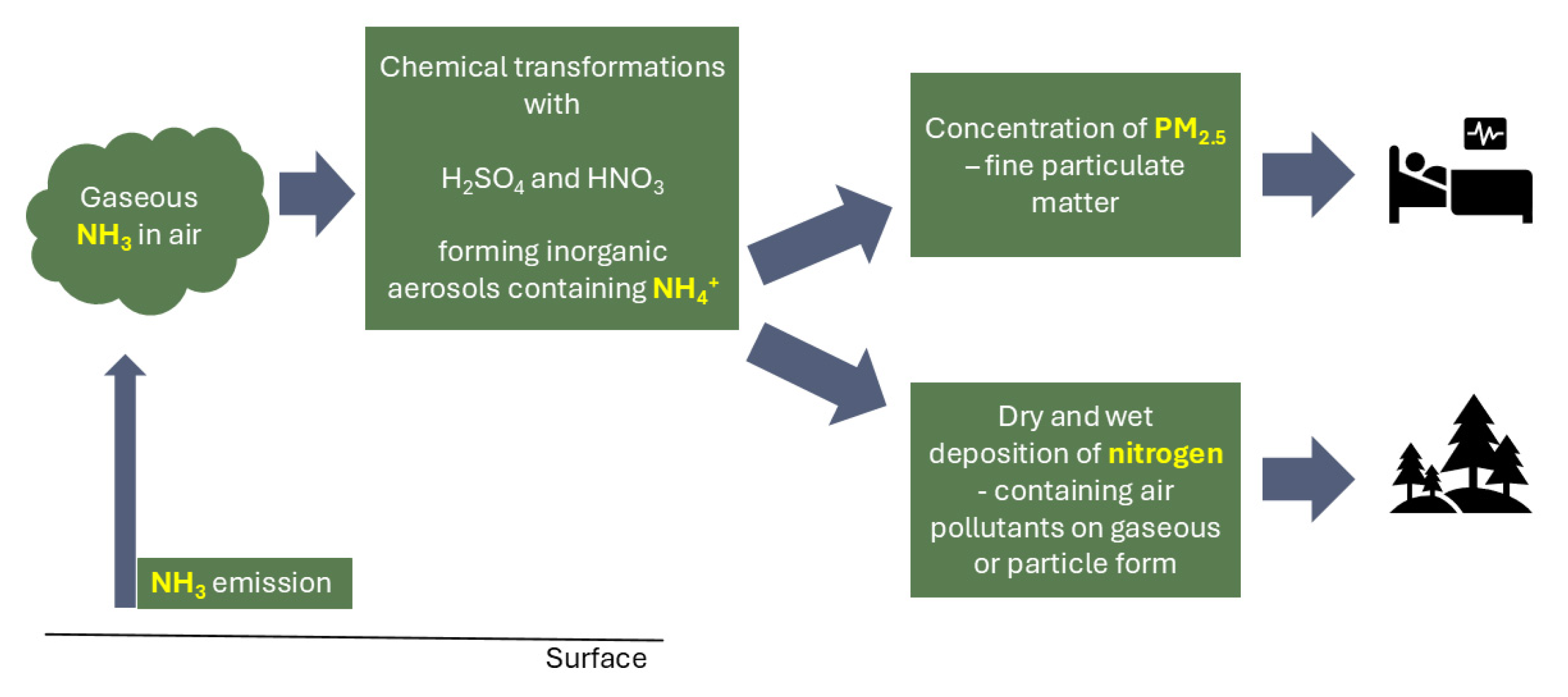
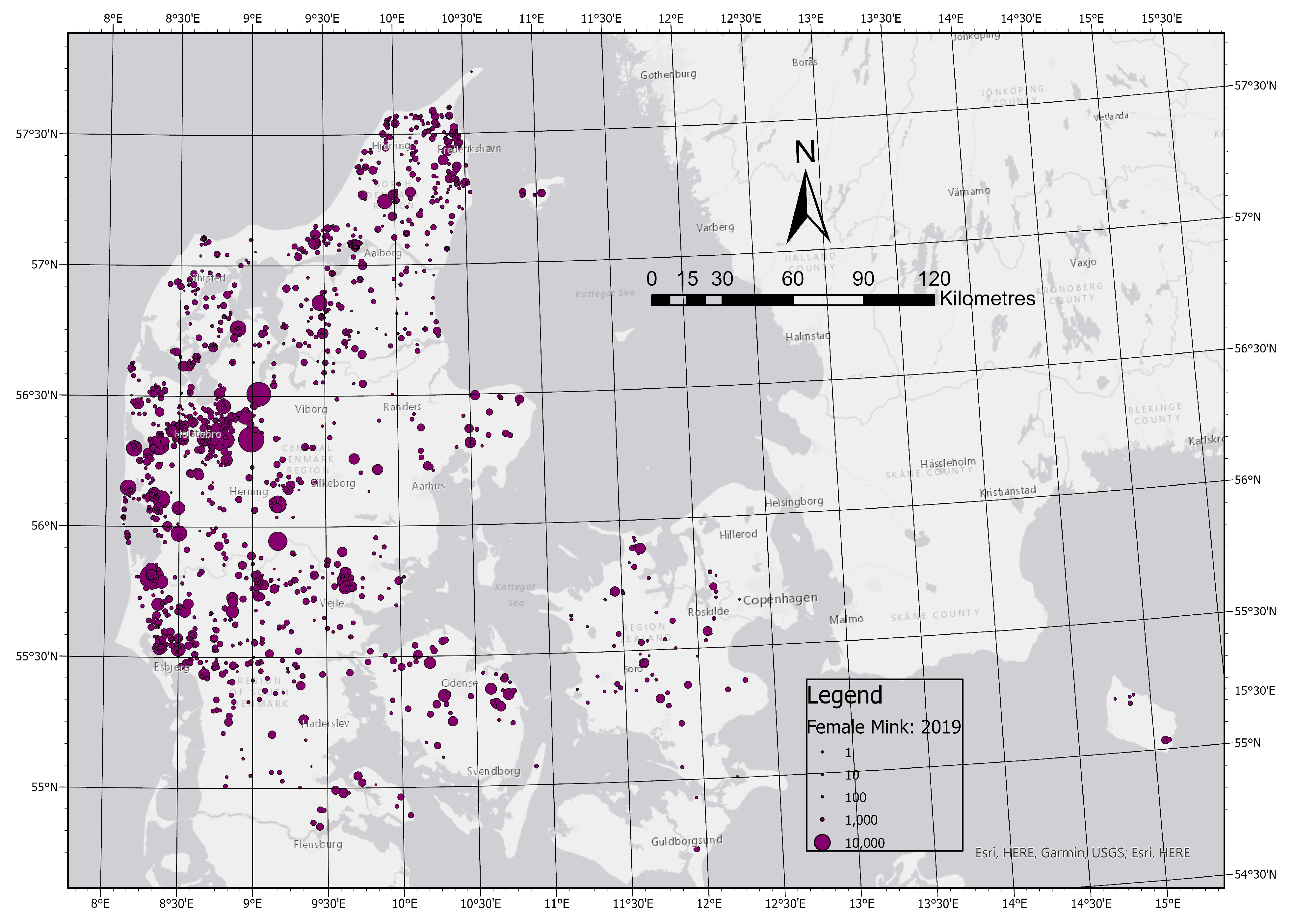
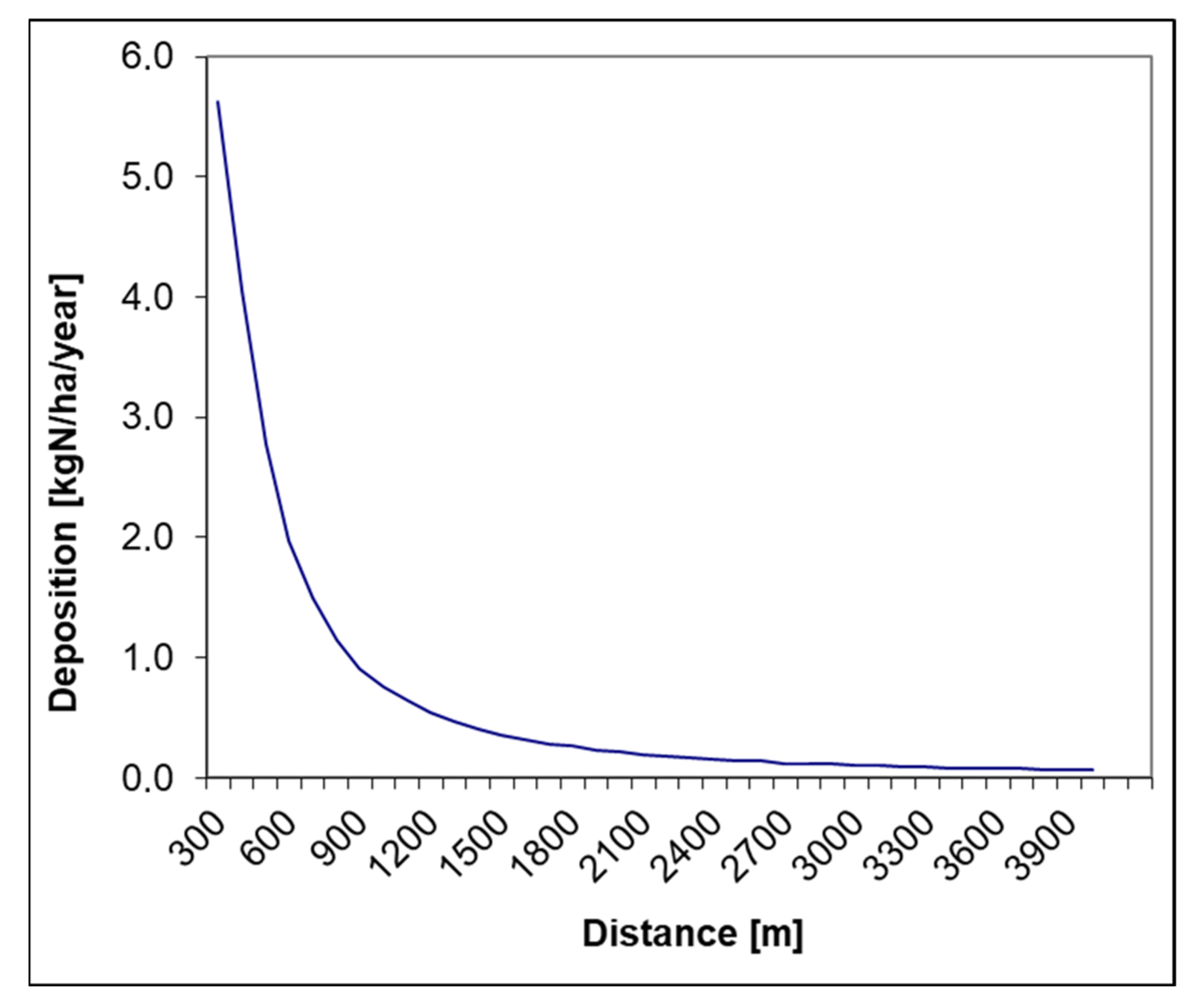

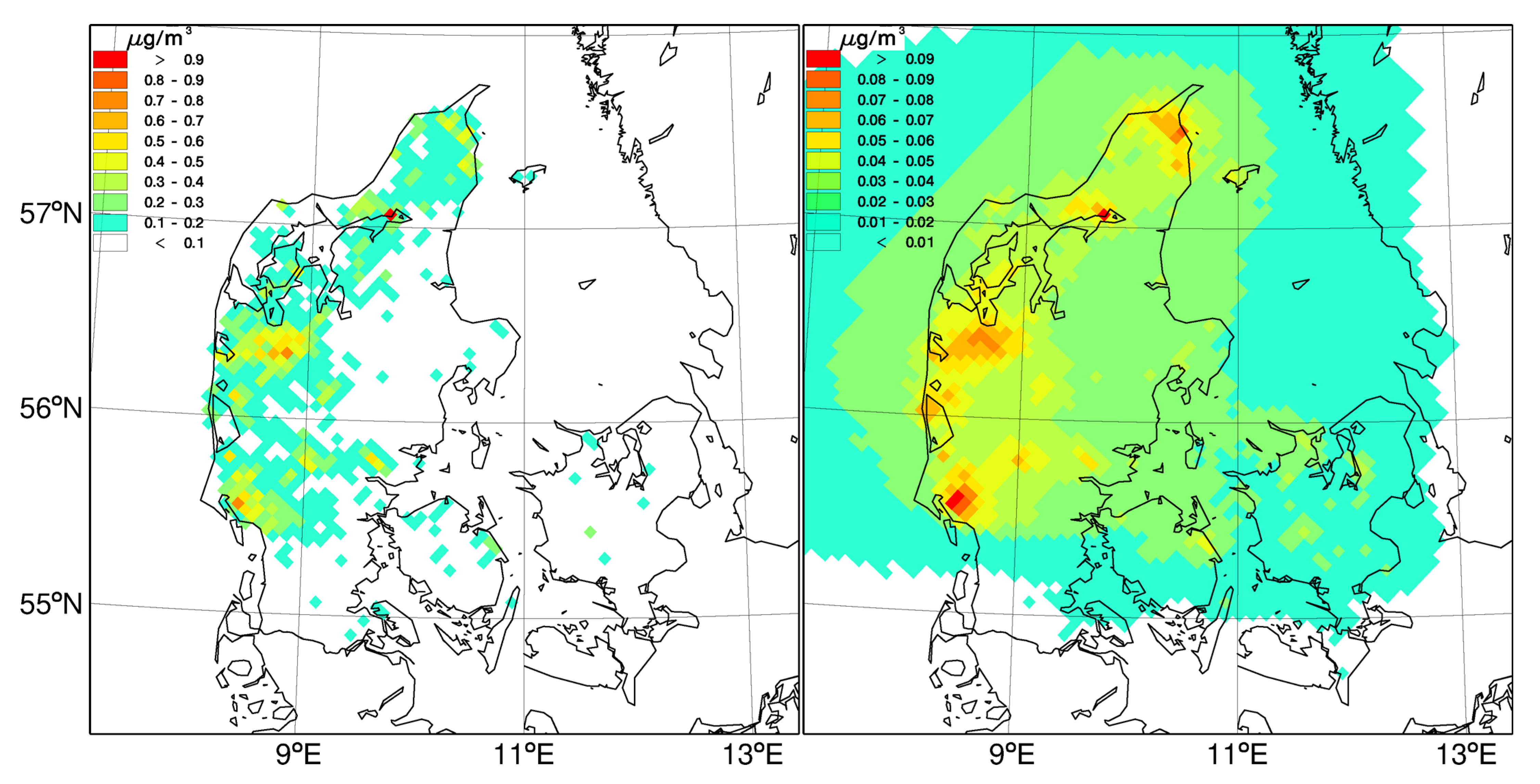

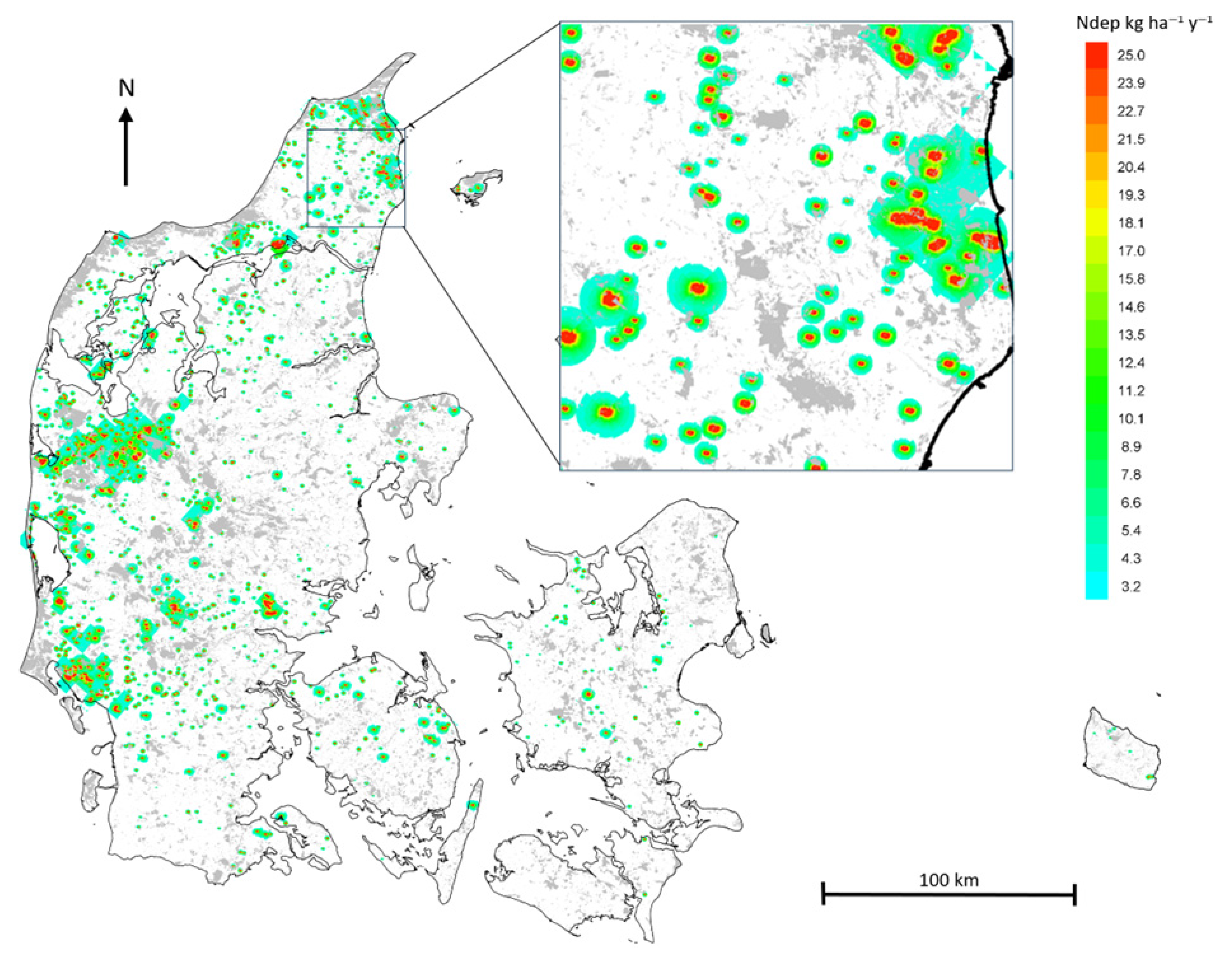
| Health Effect (Response) | Relevant Air Pollution Components | Valuation |
|---|---|---|
| Mortality | ||
| Premature deaths, short-term exposure | PM2.5, SO2, NO2, O3 | EUR 4,903,877/case |
| Premature deaths, long-term exposure | PM2.5, NO2, O3 | EUR 4,167,143/YOLL * |
| Morbidity | ||
| Respiratory hospital admissions | PM2.5, NO2, O3 | EUR 9260/case |
| Cardiovascular hospital admissions | PM2.5, O3 | EUR 15,513/case |
| Cough | PM2.5 | EUR 1418/case |
| Bronchitis | PM2.5 | EUR 49,521/case |
| Work loss days | PM2.5 | EUR 318/case |
| Restricted activity days | PM2.5 | EUR 180/case |
| Minor restricted activity days | O3 | EUR 100/case |
| Lung cancer | PM2.5 | EUR 74,804/case |
| Health Effect | Cases EU + DK | Cases DK | Costs (EUR 1000) EU + DK | Costs (EUR 1000) DK |
|---|---|---|---|---|
| Mortality | ||||
| Premature deaths, short-term exposure | 5 | 1 | 23,400 | 4840 |
| Premature deaths, long-term exposure | 57 | 11 | 108,000 | 22,200 |
| Morbidity | ||||
| Respiratory hospital admissions | 23 | 5 | 214 | 44 |
| Cardiovascular hospital admissions | 16 | 3 | 246 | 51 |
| Cough | 7 | 1 | 9 | 2 |
| Chronic bronchitis | 197 | 41 | 2390 | 492 |
| Work loss days | 2850 | 555 | 906 | 174 |
| Days with restricted activity | 37,900 | 7660 | 6820 | 1370 |
| Days with minor restricted activity | −499 | −7 | −50 | −1 |
| Lung cancer | 8 | 2 | 577 | 119 |
| Total (costs only) | 142,000 | 29,300 | ||
| Region | NH3 | NH3 Cont. | Dry Nr | Dry Nr Cont. | Wet Nr | Wet Nr Cont. | Total Nr | Total Nr Cont. |
|---|---|---|---|---|---|---|---|---|
| µgN/m3 | % | kgN/ha | % | kgN/ha | % | kgN/ha | % | |
| North Jutland | 0.96 | 6.4 | 6.95 | 4.9 | 5.51 | 1.8 | 12.5 | 3.5 |
| Mid Jutland | 1.11 | 6.1 | 7.62 | 4.6 | 5.50 | 1.7 | 13.1 | 3.4 |
| Southern Denmark | 1.33 | 3.5 | 8.48 | 3.0 | 6.08 | 0.9 | 14.6 | 2.1 |
| Capitol region | 0.68 | 1.8 | 5.90 | 0.7 | 4.71 | 0.4 | 10.6 | 0.6 |
| Zealand | 0.95 | 1.7 | 6.40 | 1.1 | 4.78 | 0.4 | 11.2 | 0.8 |
| Ʃ DK (land) | 1.09 | 4.4 | 7.43 | 3.4 | 5.50 | 1.2 | 12.9 | 2.5 |
| Ʃ DK (marine) | 2.38 | 1.3 | 3.71 | 0.5 | 6.09 | 0.8 |
| Area with Exceedance of Critical Load (ha) | With Mink | Without Mink | Difference | % |
|---|---|---|---|---|
| Category 1: NH3-sensitive light-open nature in Natura 2000 | 37,353 | 37,099 | 254 | 0.7 |
| 10,716 | 10,962 | −246 | −2.3 |
| 843 | 754 | 90 | 11 |
| Category 2: Larger heathland and grassland areas, Natura 2000 | 4778 | 3740 | 1038 | 22 |
| 367 | 367 | 0 | 0 |
| Category 3: All NH3-sensitive areas, outside Natura 2000, not included in Categories 1 and 2. | 29,484 | 26,658 | 2826 | 9.6 |
| 61,273 | 50,626 | 10,647 | 17 |
| Total | 144,814 | 130,206 | 14,609 | 10 |
Disclaimer/Publisher’s Note: The statements, opinions and data contained in all publications are solely those of the individual author(s) and contributor(s) and not of MDPI and/or the editor(s). MDPI and/or the editor(s) disclaim responsibility for any injury to people or property resulting from any ideas, methods, instructions or products referred to in the content. |
© 2025 by the authors. Licensee MDPI, Basel, Switzerland. This article is an open access article distributed under the terms and conditions of the Creative Commons Attribution (CC BY) license (https://creativecommons.org/licenses/by/4.0/).
Share and Cite
Frohn, L.M.; Bak, J.L.; Brandt, J.; Christensen, J.H.; Gyldenkærne, S.; Geels, C. Assessing the Impact of Ammonia Emissions from Mink Farming in Denmark on Human Health and Critical Load Exceedance. Atmosphere 2025, 16, 966. https://doi.org/10.3390/atmos16080966
Frohn LM, Bak JL, Brandt J, Christensen JH, Gyldenkærne S, Geels C. Assessing the Impact of Ammonia Emissions from Mink Farming in Denmark on Human Health and Critical Load Exceedance. Atmosphere. 2025; 16(8):966. https://doi.org/10.3390/atmos16080966
Chicago/Turabian StyleFrohn, Lise Marie, Jesper Leth Bak, Jørgen Brandt, Jesper Heile Christensen, Steen Gyldenkærne, and Camilla Geels. 2025. "Assessing the Impact of Ammonia Emissions from Mink Farming in Denmark on Human Health and Critical Load Exceedance" Atmosphere 16, no. 8: 966. https://doi.org/10.3390/atmos16080966
APA StyleFrohn, L. M., Bak, J. L., Brandt, J., Christensen, J. H., Gyldenkærne, S., & Geels, C. (2025). Assessing the Impact of Ammonia Emissions from Mink Farming in Denmark on Human Health and Critical Load Exceedance. Atmosphere, 16(8), 966. https://doi.org/10.3390/atmos16080966







